- Home
- Stephen E. Ambrose
The Supreme Commander Page 2
The Supreme Commander Read online
Page 2
Eisenhower took his written recommendation to Marshall, handed it to him, and said it would be a long time before major reinforcements could go to the Philippines, longer than the garrison could hold out, but the United States had to do everything possible, because “The people of China, of the Philippines, of the Dutch East Indies will be watching us. They may excuse failure but they will not excuse abandonment.…” The base should be Australia, and Eisenhower urged that Marshall start at once to expand the facilities there and to secure communications to Australia. “In this last we dare not fail. We must take great risks and spend any amount of money required.”
Eisenhower continued to emphasize the importance of making the people of Southeast Asia feel the United States was coming to their aid. He had in mind the British in Greece. A few months earlier, when the Germans threatened that country, the British had felt it was important to send a division there—even though they feared it would do no good—in order to protect their postwar political position in the Mediterranean. Eisenhower felt the Americans had to do at least as much in the Philippines.
Eisenhower’s program was exactly what Marshall had in mind. The Chief of Staff said softly, “I agree with you.” Then he added, “Do your best to save them.” Eisenhower had passed the test; now he was in charge of the Philippines and Far Eastern Section of the War Plans Division.
Then Marshall leaned forward—Eisenhower recalled years later that he had “an eye that seemed to me awfully cold”—and declared, “Eisenhower, the Department is filled with able men who analyze their problems well but feel compelled always to bring them to me for final solution. I must have assistants who will solve their own problems and tell me later what they have done.”5
CHAPTER 1
Debacle in the Pacific
As Eisenhower left Marshall’s office his mind went back twenty years, to the man he had served under in the Panama Canal Zone, Major General Fox Conner. Conner had made a deep impression upon him and was to remain the greatest single influence on his military thought. Even after he was a retired President of the United States and had worked with many of the great men of the century, Eisenhower would say, “Fox Conner was the ablest man I ever knew.”
Three things especially that Conner taught stood out. “Always take your job seriously, never yourself,” the general emphasized. “In the next war we will have to fight beside allies and George Marshall knows more about the techniques of arranging allied commands than any man I know. He is nothing short of a genius.” Conner urged Eisenhower to try for an assignment under Colonel Marshall. Finally, Conner believed that another war was inevitable, that it would be a world war, and that those who directed it would have to learn to think in terms of world rather than single-front strategy.1
In meeting his responsibilities as a staff officer for Marshall, Eisenhower could draw upon other experiences. He had never seen combat, a fact he often bemoaned, and indeed had had only limited service with troops, but he had served on the staff of such men as General John J. Pershing, Lieutenant General Walter Krueger, and General Douglas MacArthur. He had a reputation for being a good staff officer. MacArthur said Eisenhower’s chief strength was his ability to look at problems from the point of view of the high command and thought him the best drafter of papers in the Army.2
Marshall picked Eisenhower partly because of his long service with MacArthur, partly because he was known in the Army as a man who would assume responsibility. Marshall’s desire for independent men fitted in with the way he wanted War Plans Division (WPD) to operate. The division, created by the National Defense Act of 1920 as a part of the War Department General Staff, was the principal planning agency and the central operations command post. Through it Marshall controlled the “strategic direction of military forces in the theater of war.” WPD’s responsibilities grew so large that it became a kind of inner general staff. Eisenhower called it the “Command Post for Marshall.”3
In the thirties, while he was Chief of Staff, MacArthur had complained that “the War Department has never been linked to fighting elements by that network of command and staff necessary to permit the unified functioning of the American Army.”4 WPD provided the necessary links. The work involved became enormous; just six days after he joined WPD, Eisenhower told his old commander, General Krueger, “The rapid, minute-to-minute, activities of the Army seem to be centered through this place, because no one else is familiar with everything else that has been planned in the past.”5
The difficulty was, as Marshall had said, that few officers in WPD were willing to assume the responsibility Marshall wanted them to take. Eisenhower felt that everyone in WPD was afraid of Marshall. They either could not or would not speak up when in his presence, and were not making decisions. They passed along the information to Marshall and forced him to decide. One WPD officer, Eisenhower remembered, was a brilliant, capable man. He had just one fault—he got tongue-tied when he was in Marshall’s presence.
Marshall had told Eisenhower to make decisions and not bother him about them. Eisenhower did so one day and sent the result up to the division Chief, Major General Leonard Gerow. Gerow changed the decision to a recommendation and passed it on to Marshall for final action. Eisenhower confronted his superior and declared, “Gee, you have got to quit bothering the Chief with this stuff.” “I can’t help it, Ike,” Gerow replied. “These decisions are too important. He’s got to make them himself.”6
Eisenhower grew in Marshall’s estimation precisely because he was willing to make the decisions himself. A price was involved, however, one that would increase as the war went on. It was a part of a larger difficulty with the War Department that Marshall created. The Chief of Staff built a streamlined organization that could move quickly and efficiently, but it suffered from the limitations common to most bureaucracies. The emphasis, especially in WPD, was on team play and co-operation. There was little room for individual quirks or brilliance. Marshall would set the objective, which WPD would then implement. There was hardly any internal criticism of Marshall’s ideas, since the main function of WPD officers was to provide arguments for Marshall’s suggestions or to implement them. Marshall did not surround himself with yes men, nor try to, and he never discouraged criticism and intensive analysis, but the nature of the organization—and Marshall’s strong personality—precluded searching examination.
So it was with Eisenhower’s relationship with Marshall. Eisenhower was willing to take the responsibility because, in part at least, he was ordinarily confident that his solution was the one Marshall would have arrived at had he worked on the problem. Eisenhower tried to think like Marshall. He was usually successful, which made him less his own man, more Marshall’s. This relationship was efficient and probably desirable when Eisenhower was a staff officer; it would be less so when Eisenhower assumed a theater command, but by then the tendency was ingrained and had, indeed, become even more pronounced.
Following his first meeting with Marshall, Eisenhower had decided to “report to the general only situations of obvious necessity.” Once he carried that decision to the limit. He needed to transport a division to Australia and found that the British ship Queen Mary was available. Eisenhower directed the loading of 15,000 men on her and she started across the Atlantic, without escort, to go around the Cape of Good Hope. The Queen Mary was fast enough to avoid submarines, so Eisenhower was not worried until he received an intercepted cable to Rome from an Italian official in Brazil, reading: “The Queen Mary just refueled here, and with about 15,000 soldiers aboard left this port today steaming southeast across the Atlantic.” Eisenhower envisioned every German submarine in the South Atlantic concentrating on the Cape of Good Hope to send the Queen with her 15,000 men to the bottom. For a few days he slept fitfully. He did not tell Marshall, since nothing could be done and there was no point in adding to the Chief’s worries.
When the ship arrived safely, Eisenhower told the story to Marshall. The Chief smiled and said, “Eisenhower, I received that intercept
at the same time that you did. I was merely hoping that you might not see it and so I said nothing to you until I knew the outcome.”7
During his first weeks in Washington, Eisenhower spent most of his time working on the day-to-day problem of getting something, anything, into the Southwest Pacific. The biggest source of potential help was the Pensacola convoy. When the Japanese struck Pearl Harbor, a convoy of seven ships, carrying men and munitions and escorted by the cruiser Pensacola, was en route to Manila. On December 8 the Navy had ordered the convoy to put in at Suva in the Fijis to await further orders. The next day the Joint Board, composed of Army and Navy representatives, agreed to bring the ships back to Hawaii to reinforce that badly battered garrison. Gerow supported this move. Marshall concurred without comment, even though the decision represented the virtual abandonment of the Philippines. On December 10 Marshall had second thoughts and he got the Joint Board to reverse itself and reroute the convoy to Brisbane, the nearest Australian port on the western end of the continent. The Navy agreed but refused to make any promises about its ability to get the convoy from Australia to the Philippines, and the naval officers in the area soon made it clear that they felt it was not even worth attempting. MacArthur disagreed, but without the Navy’s co-operation nothing could be done.8
The Pensacola convoy thus began the implementation of the program Eisenhower had recommended in his “Steps to Be Taken” paper. Designated U. S. Army Forces in Australia (USAFIA), and eventually under the command of Lieutenant General George H. Brett, it was essentially an air and supply base, with the primary task of supporting the Philippines. Marshall put Brett under MacArthur’s orders and, in a message Eisenhower drafted, the Chief ordered Brett to arrange for the planes in the Pensacola convoy to fly northward, taking with them all the ammunition they could carry.9
Eisenhower meanwhile was getting two transports in San Francisco loaded with aircraft and ammunition to send to Brisbane and was arranging for others that could arrive early in January. Via the South Atlantic–Africa route, Eisenhower had two Pan American clippers loaded with 50-caliber ammunition heading for Australia, while the War Department had diverted fifteen heavy bombers from their various destinations to send to Brisbane. Finally, at Eisenhower’s suggestion, the War Department made $10,000,000 available to the USAFIA commander to hire blockade runners from private shippers to make the run from Australia to the Philippines.10
On paper it was an impressive program of reinforcement, but it meant nothing to the forces in the Philippines unless the airplanes and ammunition got through to them. It did cement the American commitment to defend the Southwest Pacific area, if not the Philippines, and signified the beginning of the huge American build-up in Australia.
On December 22 the Pensacola convoy arrived in Brisbane. The same day the Japanese, having secured air bases in the southernmost of the Philippine Islands, thereby assuring their domination of the air, made their major landings at Lingayen Gulf a hundred and twenty miles north of Manila. Within three days the enemy had a firm lodgment. On December 26 MacArthur declared Manila an open city, transferred his headquarters to Corregidor, and began pulling back to the Bataan Peninsula. The Japanese had complete aerial and naval supremacy and had cut the line between the Philippines and Australia.
None of the planes, men, or munitions on the Pensacola convoy ever reached the Philippines. When the crews assembled the planes they found that vital combat parts were missing; by the time these arrived from the United States everything had gone smash. A field artillery brigade, together with some ammunition, did manage to reload upon two fast ships and on December 28 left for Darwin, on the north coast of Australia. By the time it got to that port the Japanese had established themselves in Borneo, directly athwart the line of communication northward. In a masterly understatement Eisenhower, in a message he drafted for Marshall, told MacArthur, “It now appears that the plans for reaching you quickly with pursuit plane support are jeopardized.”11
The pattern of frustration set in the first weeks of the war would continue until the fall of the Philippines. Later, MacArthur charged that had there been sufficient determination in the War Department reinforcements could have reached him. The charge first appeared in Frazier Hunt’s MacArthur and the War Against Japan, published in late 1944. Eisenhower read it shortly after the liberation of Paris and recommended it to Marshall, with the caveat that “the book practically gave me indigestion.” Eisenhower also warned that “you will be quite astonished to learn that back in the Winter of ’41/’42, you and your assistants in the War Department had no real concern for the Philippines and for the forces fighting there.”12
The charge of indifference, encouraged by MacArthur, was grossly unfair. Eisenhower knew many American officers fighting in the islands, had scores of Filipino friends, and if only for personal reasons would have done everything possible to aid the defense. He suffered grievously over his inability to do anything effective. He stayed at the War Department until ten every evening, seven days a week, trying to scrape up something and find a way to get it in to MacArthur.
All Eisenhower’s efforts meant nothing to MacArthur. His forces were being beaten back, suffering heavy losses, fighting without enough ammunition, insufficient food and transport, obsolete weapons, and no air support. He received promises from Washington but, except for an occasional submarine loaded with ammunition, no material help. To MacArthur, and to the tired, dirty, hungry men of Bataan, the thought of well-dressed, comfortably housed, well-fed staff officers in Washington was infuriating. The messages from Washington describing the material being sent to Australia became a bitter joke. Washington’s encouragement, MacArthur later charged, was deliberate cruel deception. But without the ships to run supplies through the Japanese blockade, and without the planes to challenge the enemy in the sky, there was nothing Marshall and Eisenhower could do beyond building up the forces in Australia.
MacArthur argued that the Japanese blockade was ineffective and urged Marshall to force the Navy to fight its way through to the Philippines. On February 8, 1942, Eisenhower drafted Marshall’s reply. He pointed out that the War Department was well aware of the decisive effect a flank attack against Japanese communications could have, not only in breaking the blockade of the Philippines but in stopping the southward thrust of the Japanese, but many factors stood in the way. The Japanese foresight in seizing the islands of Guam, Wake, the Marshalls, and the Gilberts and establishing land-based airplanes on them gave the enemy total air superiority. American and Dutch cruisers had just suffered heavy losses in the Netherlands East Indies from land-based aircraft and the British had lost Prince of Wales and Repulse, two modern battleships, to land-based aircraft. All this, added to the experiences gained in the Mediterranean, showed conclusively that naval vessels could not operate in regions dominated by hostile aircraft.* The United States, therefore, would continue to hold to a strategy of slowing down, then halting, Japanese advances, while it built a base in Australia from which a massive counterattack could be launched.13
One of the reasons Marshall had brought Eisenhower to Washington was to deal with MacArthur. Marshall probably hoped that after all his years with the Far Eastern commander Eisenhower would know how to mollify MacArthur. In this task Eisenhower clearly and completely failed. He drafted nearly every cable Marshall sent to the Philippines; none of them, including the one summarized above, satisfied or convinced MacArthur.
The reason was, perhaps, not so much that Eisenhower was not delivering anything to the beleaguered garrison but rather that the War Department was sticking to its prewar policy of Europe first. This was partly a strategic decision forced upon the policy makers. Germany was the more dangerous enemy, Europe was closer than the Far East and so shipping men and supplies there was easier, British and Russian troops were already fighting the Nazis, and so on. But it was also a foreign policy decision of the first magnitude, for it meant that in the government’s estimation Europe was more important than Asia, at least to Americ
ans living in the middle of the twentieth century.
MacArthur disagreed, violently. He believed that Asia was the key to the future, and that it was on that continent and its offshore islands that America should make her major commitment. The split between MacArthur and Marshall could not have been more decisive. For the immediate future the problem was the moral commitment to the Philippines. MacArthur felt that Americans could never again have any influence among the Filipinos unless they made every effort to save the islands. Eisenhower agreed with this—he had said as much to Marshall his first day in Washington—but he never became a full-fledged Asia-firster, despite his years in the Philippines. For this MacArthur never forgave him.
MacArthur knew full well that not only Eisenhower and Marshall were responsible for what he called his abandonment. The decision was one that nearly every responsible official in Washington agreed to. Time and again MacArthur pleaded with the “faceless staff officers” to make the primary American effort in the Philippines. He argued that the islands could be saved if the U.S. bent every effort to the task. “The yielding of the Philippines by defeat and without a major effort would mark the end of white prestige and influence in the East,” he warned, and the United States had to either support the Philippines “or withdraw in shame from the Orient.”
But Marshall, Eisenhower, the War Department, and the British had already agreed that the program for the Far East was to hold the Malay Peninsula, if possible, and Australia and Burma, which was another way of saying that they had written off the Philippines. In a staff-prepared memorandum of January 3, WPD reinforced the decision. The fundamental consideration was that help could not be sent to the Philippines in time to save the islands (MacArthur estimated that he could hold on for three months), but beyond that the dispatch of a force that would meet the need would constitute “an entirely unjustifiable diversion of forces from the principal theater—the Atlantic.” It would take 1464 aircraft of various types, only half of which were available, to hold the Philippines. Additional airfields in Australia and along the line of advance north would have to be built, along with supporting bases. This would require large naval resources; in addition to the vessels already in the Pacific, the Allies would have to bring in seven to nine battleships, five to seven carriers, about fifty destroyers, sixty submarines, and innumerable small craft. This diversion would cause the loss of the Atlantic supply line to England, jeopardize the Middle East, and limit the defense of the Western Hemisphere. Although no one ever gave formal approval to the abandonment of the Philippines, there was general agreement that saving the islands was not worth the cost and the risk.14

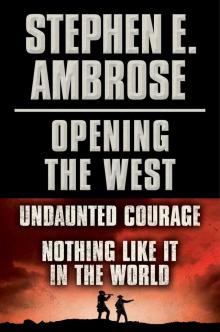 Undaunted Courage
Undaunted Courage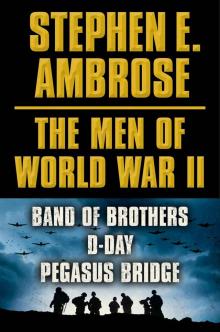 The Victors: Eisenhower and His Boys
The Victors: Eisenhower and His Boys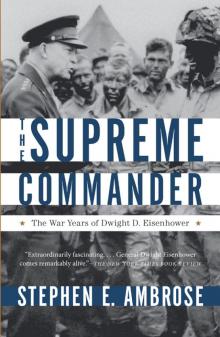 The Supreme Commander
The Supreme Commander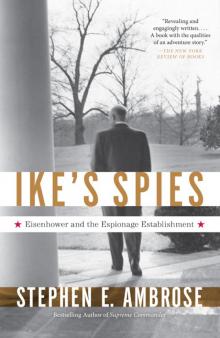 Ike's Spies: Eisenhower and the Espionage Establishment
Ike's Spies: Eisenhower and the Espionage Establishment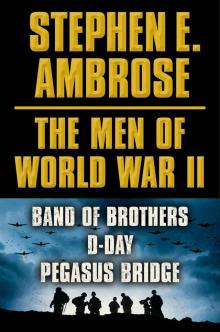 The Men of World War II
The Men of World War II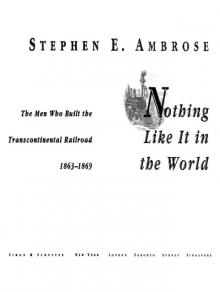 Nothing Like It in the World The Men Who Built the Transcontinental Railroad 1863-1869
Nothing Like It in the World The Men Who Built the Transcontinental Railroad 1863-1869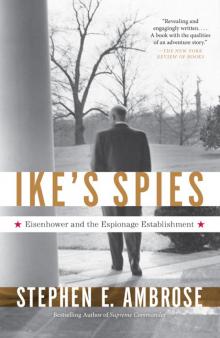 Ike's Spies
Ike's Spies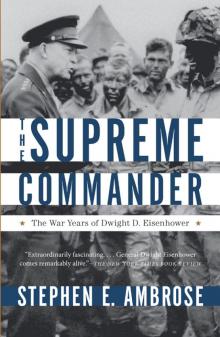 Supreme Commander
Supreme Commander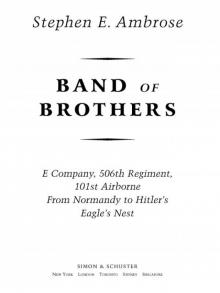 Band of Brothers
Band of Brothers